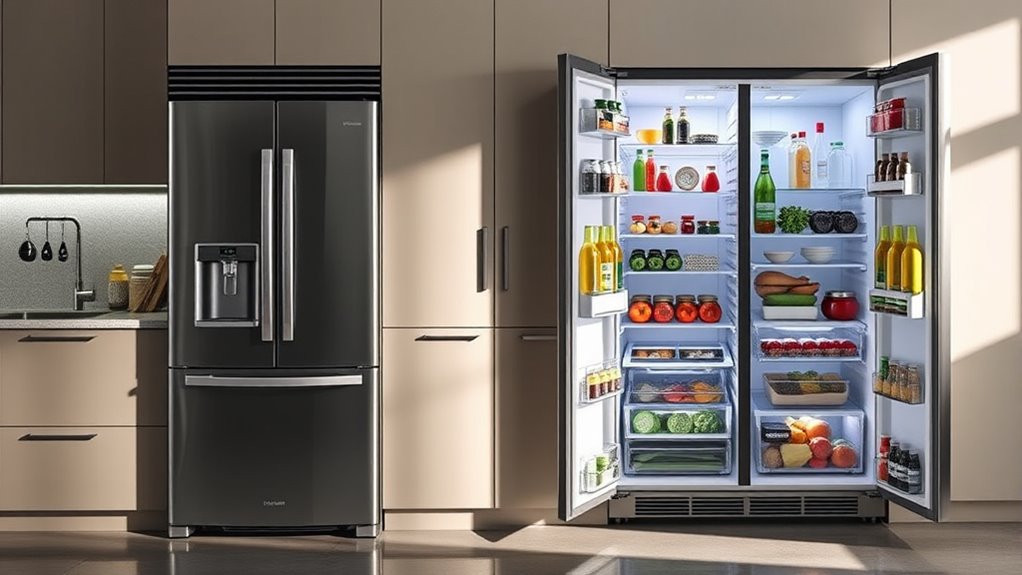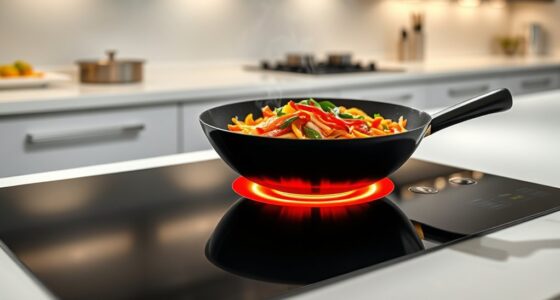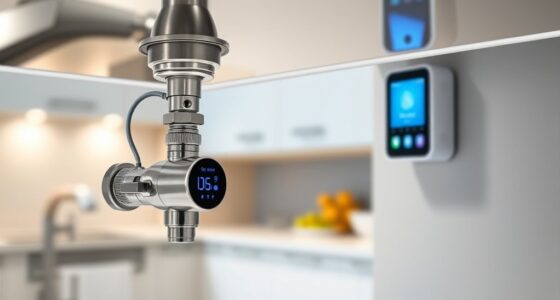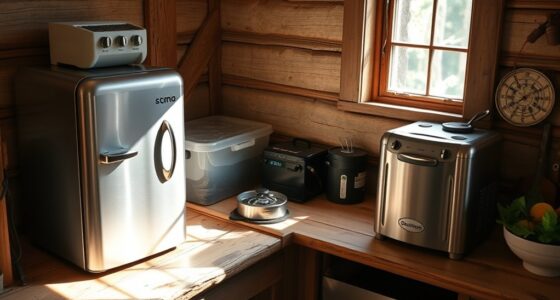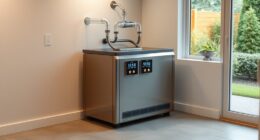Counter‑depth fridges help create a sleek, integrated look that maximizes your kitchen’s style. However, they offer about 15 to 25 cubic feet of interior space, which is less than standard models, limiting storage for bulky or large items. This trade-off means you’ll need to prioritize your space needs versus aesthetics. Want to know how to balance these factors for your kitchen? Keep exploring for more insights.
Key Takeaways
- Counter-depth fridges maximize kitchen aesthetic and space efficiency but typically offer less interior storage than standard models.
- Reduced depth limits storage for bulky items, requiring careful organization and smaller item accommodation.
- They create a seamless, built-in look that enhances modern kitchen design but may compromise on capacity.
- Standard-depth fridges provide more interior space but protrude more, affecting the kitchen’s visual flow.
- Choosing between space and storage depends on balancing aesthetic preferences with household storage needs.
Understanding the Dimensions of Counter-Depth Refrigerators
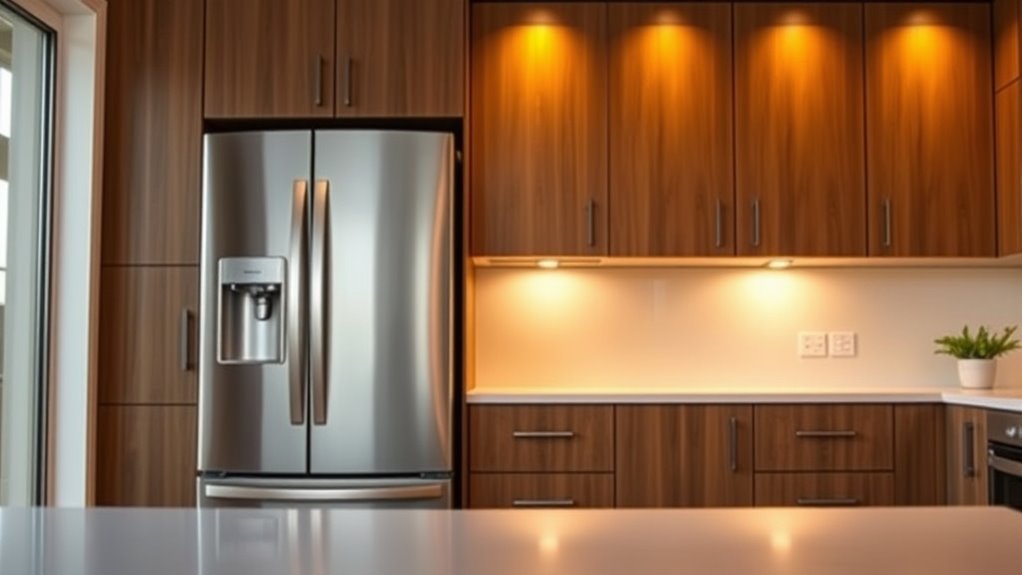
Understanding the dimensions of counter-depth refrigerators helps you choose the right model for your kitchen. These fridges typically range from 24 to 30 inches deep without handles, aligning closely with standard countertops that are 24–25 inches deep. When handles are added, the depth can reach 30 inches or slightly more, so always check specific models. Most counter-depth units are 30 to 36 inches wide and stand 66 to 72 inches tall, providing a balanced footprint that matches your kitchen’s layout. Keep in mind, manufacturers may list multiple depths depending on whether measurements include doors, handles, or hinge covers. The shallowest options start around 24 inches deep, making them ideal for limited spaces, but ensure to measure your space carefully to accommodate handles and door swing. Always verify the total depth with handles included to ensure a proper fit in your designated space, especially since counter-depth refrigerators are designed to blend seamlessly with cabinetry for a streamlined look.
How Space-Saving Design Enhances Your Kitchen Aesthetics
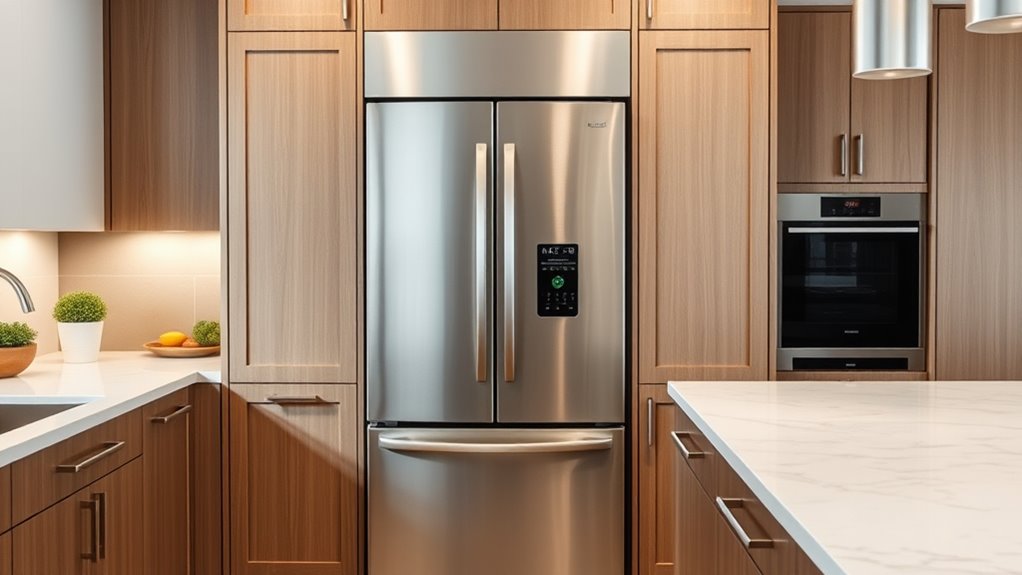
A space-saving design keeps your kitchen looking sleek and organized by seamlessly integrating appliances into your cabinetry. By reducing visual bulk and protrusions, counter-depth fridges create a clean, cohesive aesthetic that elevates your entire space. This streamlined look not only enhances beauty but also improves functionality, making your kitchen feel more open and inviting. Incorporating rustic lighting and vintage accents can further accentuate the farmhouse style, adding warmth and charm to your kitchen design.
Seamless Kitchen Integration
Seamless kitchen integration begins with the sleek design of counter-depth refrigerators, which create a modern, streamlined look by aligning perfectly with your cabinetry and countertops. Their built-in appearance offers a high-end, custom feel without a full remodel. The flush design creates cohesive visuals, blending seamlessly into your kitchen’s style. This sleek integration enhances the overall aesthetic, making your space look organized and sophisticated. It also improves flow and accessibility, reducing obstructions and making movement easier. Here’s a quick comparison:
| Feature | Benefit |
|---|---|
| Sleek Design | Modern, streamlined look |
| Built-in Appearance | Custom, high-end feel |
| Cohesive Visuals | Seamless integration |
Additionally, counter-depth refrigerators typically have dimensions that match standard cabinet depths, ensuring they sit flush with your cabinetry for a truly integrated look.
Reduced Clutter and Bulk
Counter-depth refrigerators help create a cleaner, more organized kitchen by sitting flush with your countertops and cabinets. This design reduces protrusion to about 24-25 inches, freeing up aisle space and making movement easier, especially in smaller kitchens. Less bulk means fewer obstacles, lowering the risk of bumping into the fridge and improving overall flow. The shallower depth also requires less clearance to open doors—around 36-40 inches—adding accessibility in tight spots. Visually, these fridges blend seamlessly with your cabinetry, eliminating the bulky, out-of-place feel. Their sleek, uniform appearance minimizes visual clutter and promotes a minimalist look. Plus, reduced clutter inside the fridge makes contents easier to find, encouraging tidiness and reducing frustration. Overall, space-saving design helps your kitchen appear cleaner, more open, and more functional. Additionally, counter-depth models typically have 15-20% less capacity, which encourages better organization and prevents overstocking.
Cohesive Design Aesthetics
The space-saving design of counter-depth refrigerators considerably boosts your kitchen’s visual appeal by integrating smoothly with existing cabinetry. They align flush with cabinets, creating a sleek, built-in look that eliminates bulky protrusions. The shallow depth (24 to 30 inches) helps the fridge blend seamlessly into countertop lines, enhancing uniformity and modernity. This cohesive appearance elevates your kitchen’s style and can serve as a subtle focal point. Additionally, because they are designed to match typical countertop depths, they maximize available space without sacrificing storage capacity, making them highly functional as well as stylish. Proper kitchen organization can further optimize the limited space, ensuring everything remains accessible. Counter depth refrigerators enhance overall kitchen decor, adding a high-end touch.
Balancing Capacity and Internal Storage Limitations
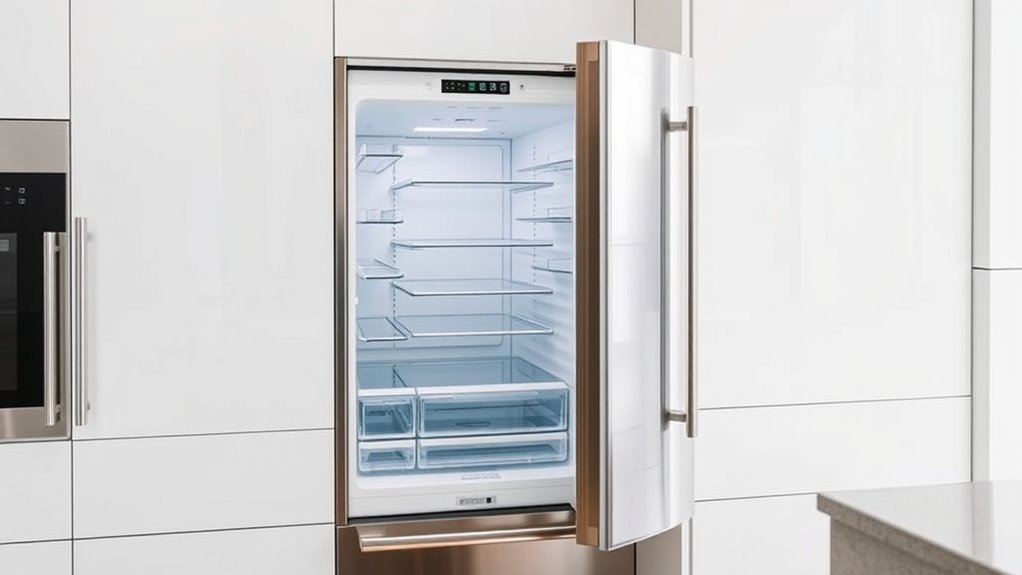
Balancing capacity and internal storage limitations is a key challenge when choosing a fridge that offers a sleek, built-in look. Counter-depth models typically range from 24 to 30 inches in depth, matching standard countertops, but they tend to be wider and taller to compensate for shallower depths. This design preserves overall capacity but often results in less interior space—usually between 15 to 25 cubic feet—compared to standard-depth fridges, which can reach 30 cubic feet or more. The reduced depth limits storage for bulky items and tall bottles, requiring better organization or more frequent shopping. Additionally, interior layout options such as tiered shelving or under-shelf storage can help improve efficiency in limited space. Moreover, storage efficiency features like door bins and adjustable dividers can maximize the usable space despite the shallower interior. Ultimately, you’ll need to weigh the aesthetic benefits of a flush look against the practical need for sufficient internal storage.
Important Measurement Tips for a Perfect Fit
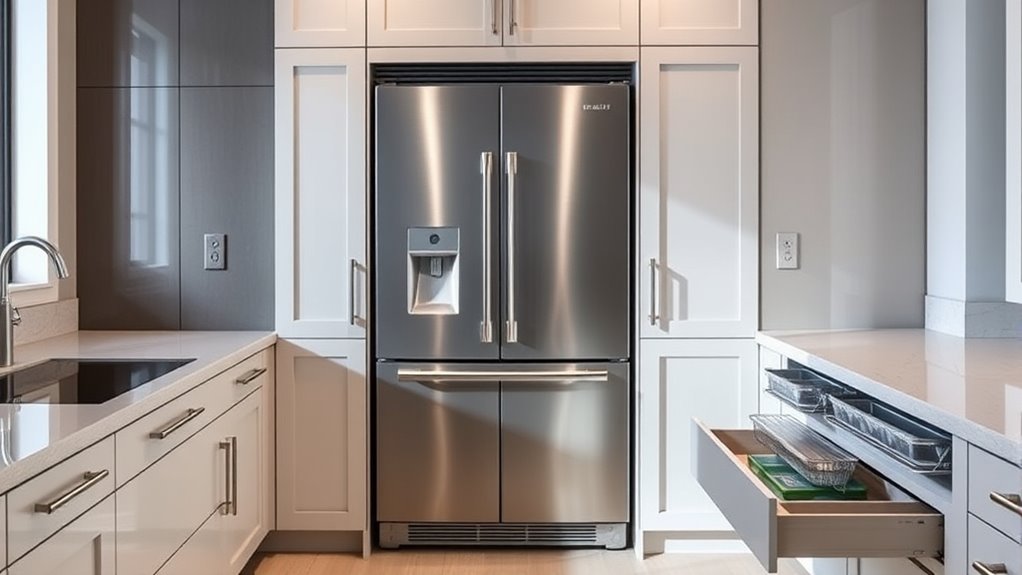
Measuring carefully is essential to guarantee your fridge fits perfectly into your space. Start by checking the depth, including handles, which can add 2 inches, making total depth up to 32 inches. Aim for a fridge depth close to your standard countertop (24–25 inches) for a flush look. Measure from the back wall to the front of your countertops or cabinets, and double-check to ensure doors and handles won’t hit obstacles. Also, measure the width between cabinets, leaving 1–2 inches for ventilation and easier installation. Don’t forget to check the height—measure from the floor to the underside of overhead cabinets. Lastly, consider door swing clearance, allowing enough space for full door opening and easy access. Accurately measuring all dimensions is crucial for a seamless fit, especially since precise measurements can prevent costly mistakes.]
- Confirm handle and hardware dimensions to avoid surprises
- Measure both the opening width and depth precisely
- Account for ventilation space around the fridge
- Use a mockup or cardboard template to visualize door swing
Features and Configurations That Maximize Usable Space
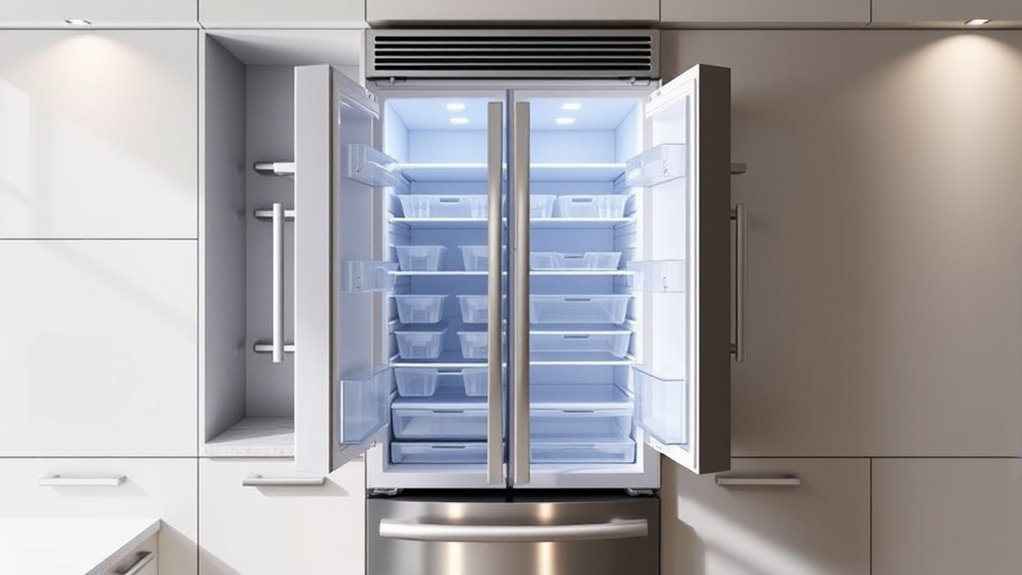
Counter-depth refrigerators are designed to maximize your kitchen’s usable space by aligning with cabinetry and minimizing protrusion. They typically measure 24 to 30 inches deep, creating a sleek, built-in look that frees up floor space. To compensate for reduced depth, many models are wider and taller, maintaining comparable storage capacity. Features like adjustable glass shelves, clear door bins, and crisper drawers boost organization and customization. Different configurations—French door, side-by-side, top-freezer, or bottom-freezer—offer flexibility based on your storage needs. Door handles and design are optimized to reduce protrusion and enhance accessibility, even in tight spaces. These thoughtful design elements help you maximize interior use while preserving a seamless, integrated kitchen aesthetic. Counter-depth models are often more expensive than standard models, but they provide a sleek look that can elevate your kitchen’s overall design.
Choosing the Right Model: Prioritizing Style or Storage
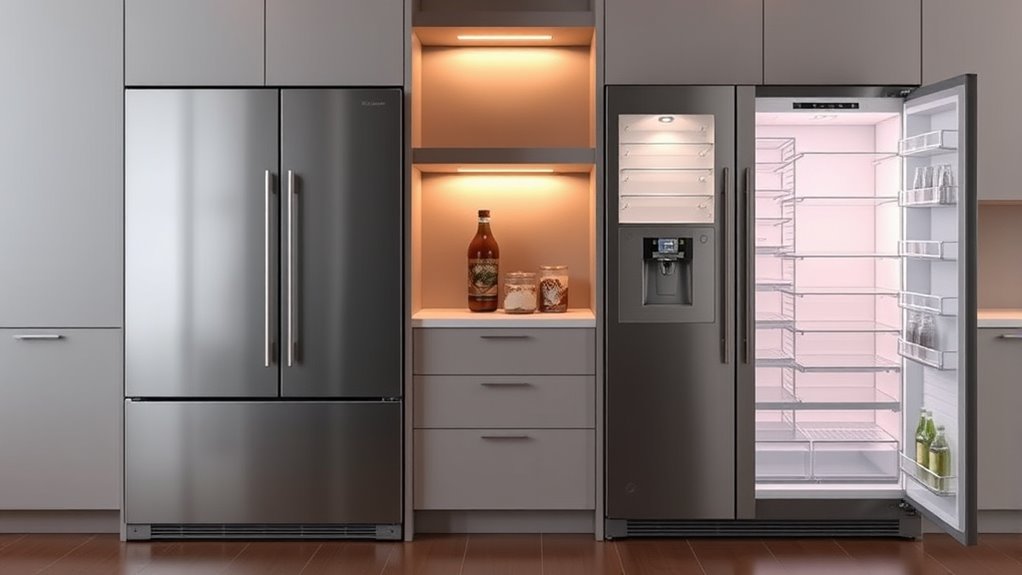
When choosing a refrigerator, your decision often comes down to whether you prioritize style or storage capacity. Counter-depth models offer a sleek, integrated look that blends seamlessly with your cabinets, making aesthetics a key factor. If you value design flexibility, options like custom panels and various configurations can enhance your kitchen’s look. However, they typically have less storage—around 15 to 25 cubic feet—compared to standard-depth models. This means less space for large items or big families. Consider your lifestyle: if you entertain often or need extra room, a standard-depth fridge might be better. Conversely, if a modern, streamlined appearance is your goal, prioritizing style could lead you to a counter-depth model. Counter-depth refrigerators have less interior storage due to reduced size so it’s important to assess how much space you need for your groceries. Additionally, the reduced size can make accessing items easier and more convenient in tight kitchen spaces. Evaluate your needs carefully before making a decision.
Frequently Asked Questions
How Much Does a Typical Counter-Depth Refrigerator Cost?
You’re probably wondering how much a typical counter-depth refrigerator costs. These models usually range from $900 to $2,400, depending on the brand, features, and finish. Premium models with advanced features or special finishes can push the price above $3,000. Keep in mind, they tend to be more expensive than standard-depth units because of their sleek design, space-saving benefits, and integrated look, making them a popular choice for modern kitchens.
Are Counter-Depth Refrigerators Energy-Efficient Compared to Standard Models?
You might wonder if counter-depth refrigerators are energy-efficient compared to standard models. They often are, thanks to innovative features like inverter compressors and smart cooling systems that optimize energy use. Many are Energy Star certified, indicating lower electricity consumption. Despite their compact design, they usually match or exceed standard models in efficiency. Keep in mind, the specific brand and features can affect overall performance, but generally, counter-depth units are quite energy-friendly.
Can I Retrofit My Kitchen to Accommodate a Counter-Depth Fridge?
You can retrofit your kitchen for a counter-depth fridge if you measure carefully and plan ahead. Make sure there’s enough space—at least 24–25 inches deep—and check your cabinetry for modifications. You’ll need proper ventilation and clearance for door swings. Be prepared for some adjustments, like widening cabinets or modifying existing ones, and keep in mind that you might lose some storage space. Proper planning makes the retrofit successful.
What Are Common Maintenance Issues With Counter-Depth Refrigerators?
Did you know that nearly 60% of refrigerator repairs are due to airflow or sealing problems? When it comes to maintenance, you’ll often face issues like insufficient cooling caused by blocked vents or faulty door seals. Regularly cleaning vents, inspecting door gaskets, and leveling your fridge can prevent temperature inconsistencies. Keep an eye on these areas to make certain your counter-depth fridge runs efficiently and lasts longer.
Do Counter-Depth Models Have Better Resale Value?
When considering resale value, counter-depth fridges don’t necessarily have an advantage over standard models. You might find that brand, condition, and features matter more than depth. While counter-depth units can appeal to buyers seeking sleek, modern kitchen designs, they often come with a higher price tag and limited storage, which could deter some buyers. Overall, your fridge’s resale value depends more on its condition and market demand than on its depth.
Conclusion
Choosing a counter-depth fridge means balancing sleek style with practical storage. Did you know that these models typically reduce interior capacity by about 10-15% compared to standard refrigerators? But with careful measurement and smart features, you can enjoy a modern, space-efficient kitchen without sacrificing too much storage. It’s all about finding the right fit for your needs—so prioritize what matters most and make your kitchen both beautiful and functional.
I’m Theodore, and I love tiny houses. In fact, I’m the author of Tiny House 43, a book about tiny houses that are also tree houses. I think they’re magical places where imaginations can run wild and adventures are just waiting to happen.
While tree houses are often associated with childhood, they can be the perfect adult retreat. They offer a cozy space to relax and unwind, surrounded by nature. And since they’re typically built on stilts or raised platforms, they offer stunning views that traditional homes simply can’t match.
If you’re looking for a unique and romantic getaway, a tree house tiny house might just be the perfect option.
